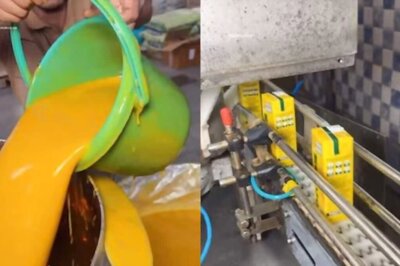
views
CHENNAI: The common fear among the people of Idinthakarai, about three km north of Koodankulam, is that they would be the worst hit if a cataclysmic event occurs in the Koodankulam Nuclear Power Plant (KKNPP), as their’s is the habitation that is closest to the reactor.That they are not going to give up the present agitation is evident not only from the harangue that one hears at the protest pandal or the slogans they raise or from the visible determination but from the preparations they are making to carry on even after the rainy season starts.Work is on to erect a massive pandal with sloping roof as the present one with flat roof may not be robust enough to withstand the rains. Lorries bring in poles and other material for the new pandal even as the protest is on.In fact, the people have been supporting the campaign against the setting up of the plant right from the beginning. When anti-nuclear activists visited various villages around the proposed site in the early 1990s, the people of Koodunkulam attacked them. “We were almost physically assaulted and we had to run for cover,” recalls S P Udayakumar, the man who is now spearheading the movement against KKNPP.But at Idinthakarai, the awareness level has always been high, thanks to the local parish priests who had sensitised them. The present mobilisation of support for the protests has also been done by the Roman Catholic Church. Apart from the fact that the ground on which the protests are now held belongs to the 100-year-old church dedicated to Our Lady of Lourdes, even the village committee members refuse to speak out without a nod from the Church authorities.However, that does not mean it is purely a show of local Roman Catholic fishermen. Even Hindu fishermen of the village are part of the agitation. Ganesan, a fisherman, has not put out to the sea since the agitation started in September. He says this is a time of bumper catches and there is scope for raking in lakhs of rupees. Yet, he has decided to take part in the protest as he is determined to stop the nuclear project. “Nobody can stop us, we will fight till the end,” he says with a tinge of regret in missing out on the benefit of the season. “Maybe by next week, we will resume fishing but the protests will go on,” he says.So, how do they feed themselves? A couple of fishermen who hang out in the vicinity of the protest pandal say that they depend only on their savings. “Mother Sea will compensate us with her bounty later,” they say.Apart from fishing operations, even the shops in the village remain closed. “But shopkeepers are allowed to open for a few hours, so they are not that badly affected. Only we are going without any income,” say the fishermen.It is not only the fishermen who talk about the hazards of having a nuclear plant in their midst, even the women and children speak about it. Not only do they reel out scientific details to argue their case, they also attribute political motives — both national and international — to the setting up of the nuclear plant.As speaker after speaker takes up the microphone, the crowds, mainly women and kids, listen with rapt attention. A plethora of subjects ranging from alternative energy resources to Indo-Russian relationship to the Centre’s cheap tactics to hazards of nuclear radiation are dwelt upon by the speakers.




















Comments
0 comment